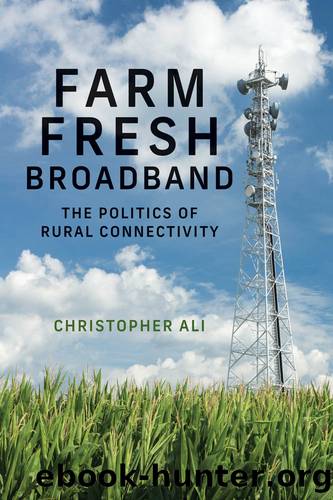Farm Fresh Broadband: The Politics of Rural Connectivity by Christopher Ali

Author:Christopher Ali [Ali, Christopher]
Language: eng
Format: epub
Tags: Technology & Engineering, Data Transmission Systems, Broadband, Social Aspects, Social Science, sociology, Rural
ISBN: 9780262543064
Google: FAg_EAAAQBAJ
Publisher: MIT Press
Published: 2021-09-21T00:25:22.773523+00:00
The story of PRTC reminds us that, at its core, rural broadband is not about policy but about people. Itâs about the quality of life we enjoy, the information we consume, the businesses we run, and the health care we receive. It speaks both to the future for an impoverished community and the future of connectivity. Indeed, it reminds us that while federal policy is crucial, rural broadband is lived by those people and companies serving rural communities in geographically embedded places. As we learned in chapter 2, the large national providers disfavor rural broadband deployment and have been less responsive to community needs than consumers desire. Instead, rural cooperatives, municipalities, and local ISPs are leading the charge for rural connectivity. All of this is embodied in the PRTC.
Yes, broadband is about peopleâusers, businesses, and providersâbut the story of PRTC also reminds us about something else: that broadband is fundamentally local. By this, I mean the technologies of access, be they mobile, fiber, or wireless, terminate at a geographically local destination. The companies successfully closing the digital divide are locally based, be they cooperatives, municipalities, or local providers. State-level policies, when articulated correctly, empower local communities and cooperatives. Local partnerships, organizations, and community members become champions of connectivity; and, of course, the users are local, for we are always in situ, in place, even when we are saving our pages to the cloud (Casey 2013).
That âall broadband is local,â as Olivier Sylvain (2012) powerfully argues, epitomizes my argument that the solution to the rural-urban digital divide will be found not in the boardrooms of national providers and global telecommunications firms but at the local level. Throughout rural America, communities have come together to address their own digital infrastructure needs. These communities have gone about it themselves by developing municipal broadband plans, mobilizing electric and telephone cooperatives to take on the burden, and organizing public-private partnerships to roll out fiber or fiber-fueled fixed wireless networks. Many rural communities are navigating the inchoate array of federal policies, programs, and subsidies described in chapters 2 and 3 and are partnering with state rural broadband offices, and with each other, to meet their constituentsâ digital needs. In doing so, they are the unsung heroes of rural broadband.
The academic literature on cooperatives often invokes the idea of a âcooperative commonwealthââa social-democratic alternative to the machinations of neoliberal capitalism that privileges quarterly profits over long-term vision and community solidarity (Keillor 2000; Schneider 2018). With rural broadband we see the emergence of a connected cooperative commonwealth, either in actual electric and telephone cooperatives or simply in the form of neighborly cooperation. As Eric Ogle (2019), senior consultant at Magellan Advisors, recently pondered, âWhat if rural communities begin thinking about broadband competition as a way to keep money circulating through a local economy?â (38). Rural communities are not just thinking about these microeconomic initiatives, they are living them through broadband deployment.
In 2019, there were over 560 communities with some form of municipal networkâmeaning networks that have been at least partially funded by local public dollars (more on this below).
Download
This site does not store any files on its server. We only index and link to content provided by other sites. Please contact the content providers to delete copyright contents if any and email us, we'll remove relevant links or contents immediately.
| Automotive | Engineering |
| Transportation |
Machine Learning at Scale with H2O by Gregory Keys | David Whiting(4179)
Never by Ken Follett(3790)
Urban Outlaw by Magnus Walker(3340)
OPNsense Beginner to Professional by Julio Cesar Bueno de Camargo(3251)
Sapiens and Homo Deus by Yuval Noah Harari(2987)
Will by Will Smith(2792)
A Short History of Nearly Everything by Bryson Bill(2629)
Hooked: A Dark, Contemporary Romance (Never After Series) by Emily McIntire(2500)
Rationality by Steven Pinker(2291)
Borders by unknow(2229)
The Becoming by Nora Roberts(2087)
Holy Bible (NIV) by Zondervan(2086)
The One Percenter Encyclopedia by Bill Hayes(1787)
HBR's 10 Must Reads 2022 by Harvard Business Review(1777)
Freedom by Sonny Barger(1771)
A Short History of War by Jeremy Black(1762)
Five Ways to Fall by K.A. Tucker(1700)
Go Tell the Bees That I Am Gone by Diana Gabaldon(1687)
Girls Auto Clinic Glove Box Guide by Patrice Banks(1685)
